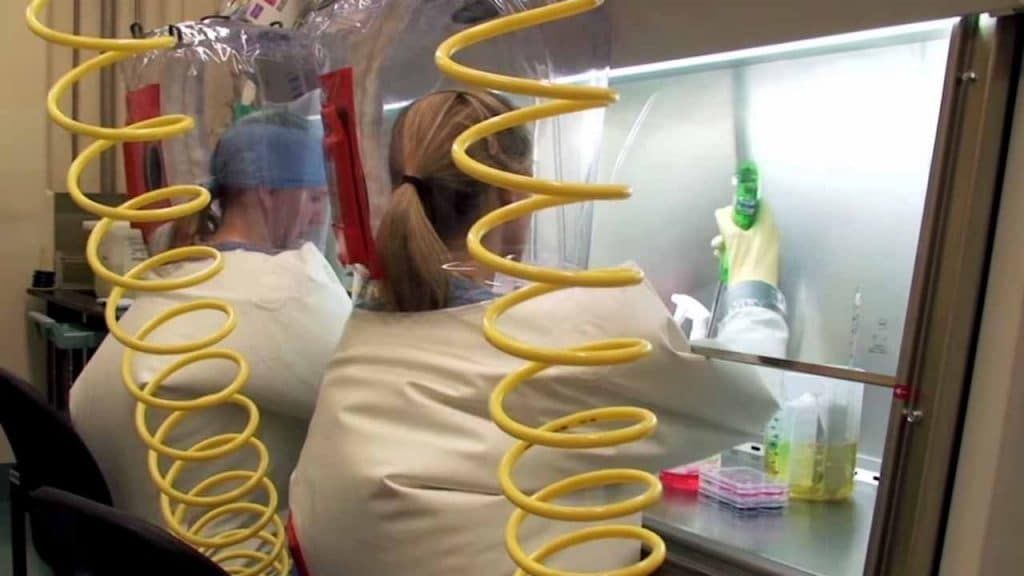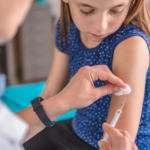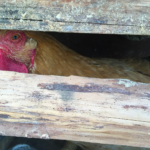The Bulletin brings top researchers to Geneva to talk biosecurity and pathogen research
By Matt Field | April 18, 2023
 Researchers wearing positive pressure personnel suits at a US National Institute of Allergy and Infectious Diseases biosafety level 4 lab. Credit: National Institute of Allergy and Infectious Diseases.
Researchers wearing positive pressure personnel suits at a US National Institute of Allergy and Infectious Diseases biosafety level 4 lab. Credit: National Institute of Allergy and Infectious Diseases.
Whether it’s a publish-first, ask-hard-biosecurity-questions second attitude or the international proliferation of biosafety labs that study or manipulate the world’s most dangerous viruses, top virologists and other biological experts will have plenty to discuss when they meet later this week for a conference on the future of pathogen research in Geneva, Switzerland.
The Bulletin’s Pathogens Project conference includes leading scientists and researchers who will unpack, among other topics, international mechanisms for managing biological risks, the role of journalism in covering biorisks, and future threats, natural and manmade, in the biological realm. At a time when governments and non-governmental organizations are debating pathogen research and biosecurity policies, a Bulletin-organized task force has begun the process of identifying national and international policies that will improve the safety and security of pathogen research.
“Our aim is to catalyze an inclusive and broad discussion among scientists and other interested stakeholders of the risks and benefits of potential pandemic pathogen research, and how such research may be conducted in a maximally de-risked manner,” Jesse Bloom, a project co-director and professor at the Fred Hutchinson Cancer Center and Investigator of the Howard Hughes Medical Institute, said in a Bulletin press release.
The conference, which begins Wednesday and continues Thursday, comes as the debate over how COVID-19 first infected humans, polarizing from nearly the outset, is once again heating up. So far scientific and intelligence agency inquiries into the pandemic’s origins have offered little closure on the origins question. Proponents of the so-called “lab leak” origin theory, who believe research at a lab studying bat coronaviruses in Wuhan, China, may have sparked the pandemic, argue that Chinese government stonewalling and efforts to downplay the possibility of a lab accident by Western scientists and science funders have resulted in inadequate investigation of the theory. In February, an intelligence report from the US Energy Department judged (with low confidence) that the pandemic originated in a lab, a conclusion similar to one reached earlier by the FBI. Four US intelligence agencies believe that SARS-CoV-2 first started circulating after a natural zoonotic spillover, but none of the six groups to weigh in had more than low or moderate confidence in their conclusions. Meanwhile, research published in Science last year suggested a pattern of COVID-19 spreading from a Wuhan market where susceptible animals were sold. More recently, scientists discovered raccoon dog and other animal DNA on swabs from the market that also tested positive for SARS-CoV-2, the COVID-19 virus.
Although questions about how the COVID-19 pandemic began remain unanswered, one reality is clear: Countries are building more and more labs equipped to handle work on the riskiest pandemic capable viruses at a fast clip. Last year, the Global Biolabs project, which monitors high-level pathogen labs and biorisk management policies and has a partnership with the Bulletin, identified 69 biosafety level 4 (BSL-4) labs—which handle viruses for which there is no known treatment or cure—in operation, under construction, or planned, 10 more than in 2021. Several countries that have or will have BSL-4 labs score poorly on Global Biolabs’ measures of biosecurity, biosafety, or dual-use research governance policies
In addition to lab oversight issues, the relative benefits and risks of certain pathogen research pursuits are a matter of considerable debate. Critics point to viral manipulation experiments where, say, researchers combine elements of one virus with that of another, to study the characteristics of the resulting chimera, which could have an enhanced ability to infect or sicken humans. While some researchers argue that these “gain-of-function” experiments can push medical science forward by highlighting, for example, the dangerous mutations to watch out for in natural pathogens, they also create the risks of an accident involving a novel pathogen.
Moreover, in the current state of life sciences research governance, researchers disagree over key definitions relevant to biosecurity, including what constitutes a gain-of-function experiment. In some cases, biosecurity considerations have come into play after studies are made public, rather than before
Climate change, human incursion into natural areas, and food-production processes may all be conspiring to increase the risks of pathogen spillover into humans. How to study these pathogens safety—to mitigate the impact of future disease outbreaks without creating opportunities for such outbreaks—is a topic worth talking about.
Together, we make the world safer.
The Bulletin elevates expert voices above the noise. But as an independent nonprofit organization, our operations depend on the support of readers like you. Help us continue to deliver quality journalism that holds leaders accountable. Your support of our work at any level is important. In return, we promise our coverage will be understandable, influential, vigilant, solution-oriented, and fair-minded. Together we can make a difference.
Keywords: COVID-19, gain-of-function research, pandemic origin
Topics: Biosecurity














